- Home
- Bill Bryson
The Mother Tongue Page 4
The Mother Tongue Read online
Page 4
A vital adjunct to language is the gesture, which in some cultures can almost constitute a vocabulary all its own. Modern Greek has more than seventy common gestures, ranging from the chopping off the forearm gesture, which signifies extreme displeasure, to several highly elaborate ones, such as placing the left hand on the knee, closing one eye, looking with the other into the middle distance and wagging the free hand up and down, which means “I don’t want anything to do with it.” According to Mario Pei, the human anatomy is capable of producing some 700,000 “distinct elementary gestures” of this type. We have nothing remotely like that number in English, but we have many more than you might at first think—from wagging a finger in warning at a child, to squeezing the nose and fanning the face to indicate a noisome smell, to putting a hand to the ear as if to say, “I can’t hear you.”
Estimates of the number of languages in the world usually fix on a figure of about 2,700, though almost certainly no one has ever made a truly definitive count. In many countries, perhaps the majority, there are at least two native languages, and in some cases—as in Cameroon and Papua New Guinea—there are hundreds. India probably leads the world, with more than 1,600 languages and dialects (it isn’t always possible to say which is which). The rarest language as of 1984 was Oubykh, a highly complex Caucasian language with eighty-two consonants but only three vowels, once spoken by 50,000 people in the Crimea. But as of July 1984 there was just one living speaker remaining and he was eighty-two years old.
The number of languages naturally changes as tribes die out or linguistic groups are absorbed. Although new languages, particularly creoles, are born from time to time, the trend is toward absorption and amalgamation. When Columbus arrived in the New World, there were an estimated 1,000 languages. Today there are about 600.
Almost all languages change. A rare exception is written Icelandic, which has changed so little that modern Icelanders can read sagas written a thousand years ago, and if Leif Ericson appeared on the streets of Reykjavik he could find his way around, allowing for certain difficulties over terms like airport and quarter-pound cheeseburger. In English, by contrast, the change has been much more dramatic. Almost any untrained person looking at a manuscript from the time of, say, the Venerable Bede would be hard pressed to identify it as being in English—and in a sense he or she would be right. Today we have not only a completely different vocabulary and system of spelling, but even a different structure.
Nor are languages any respecters of frontiers. If you drew a map of Europe based on languages it would bear scant resemblance to a conventional map. Switzerland would disappear, becoming part of the surrounding dominions of French, Italian, and German but for a few tiny pockets for Romansh (or Rumantsch or Rhaeto-Romanic as it is variously called), which is spoken as a native language by about half the people in the Graubünden district (or Grisons district—almost everything has two names in Switzerland) at the country’s eastern edge. This steep and beautiful area, which takes in the ski resorts of St. Moritz, Davos, and Klosters, was once effectively isolated from the rest of the world by its harsh winters and forbidding geography. Indeed, the isolation was such that even people in neighboring valleys began to speak different versions of the language, so that Romansh is not so much one language as five fragmented and not always mutually intelligible dialects. A person from the valley around Sutselva will say, “Vagned nà qua” for “Come here,” while in the next valley he will say, “Vegni neu cheu” [cited in The Economist, February 27, 1988]. In other places people will speak the language in the same way but spell it differently depending on whether they are Catholic or Protestant.
German would cover not only its traditional areas of Germany, Austria, and much of Switzerland, but would spill into Belgium, Czechoslovakia, Romania, Hungary, the Soviet Union, and Poland, and it could be further divided into high and low German, which have certain notable differences in terms of vocabulary and syntax. In Bavaria, for instance, Samstag is the name for Saturday, but in Berlin it is Sonnabend; a plumber in Bavaria is a spengler, but a klempner in Berlin.
Italy, too, would appear on the map not as one language entity but as a whole variety of broadly related but often mutually incomprehensible dialects. Italian, such as it is, is not a national language, but really only the dialect of Florence and Tuscany, which has slowly been gaining preeminence over other dialects. Not until 1979 did a poll show for the first time that Italian was the dialect spoken at home by more than 50 percent of Italians.
Much the same would be the position in the Soviet Union, which would dissolve into 149 separate languages. Almost half the people in the country speak some language other than Russian as a native tongue, and a full quarter of the people do not speak Russian at all.
Such pockets would be everywhere. Even Latin would make an appearance: It is still the official language of Vatican City.
All these languages blend and merge and variously affect one another. French normally puts the adjective after the noun it is modifying (as in l’auto rouge rather than le rouge auto), but in Alsace and other Rhineland regions influenced by Germany, the locals have a tendency to reverse the normal order. In a similar way, in the Highlands of Scotland, English speakers, whether or not they understand Gaelic, have developed certain speech patterns clearly influenced by Gaelic phrasings, saying “take that here” rather than “bring that here” and “I’m seeing you” in preference to “I see you.” In border areas, such as between Holland and West Germany or between West Germany and Denmark, the locals on each side often understand each other better than they do their own compatriots.
Some languages are not as distinct as we are sometimes led to believe. Spanish and Portuguese are closely enough related that the two peoples can read each other’s newspapers and books, though they have more difficulty understanding speech. Finns and Estonians can freely understand each other. Danes, Swedes, and Norwegians often insist that their languages are quite distinct and yet, as Mario Pei puts it, there are greater differences between Italian dialects such as Sicilian and Piedmontese than there are between any of the three main Scandinavian languages. Romanian and Moldavian, spoken in the Soviet Union, are essentially the same language with different names. So are Serbian and Croatian, the only real difference being that Serbian uses the Cyrillic alphabet and Croatian uses Western characters.
In many countries people use one language for some activities and a second language for others. In Luxembourg, the inhabitants use French at school, German for reading newspapers, and Luxemburgish, a local Germanic dialect, at home. In Paraguay, people conduct business in Spanish, but tell their jokes in Guarani, the native Indian tongue. In Greece, for a long time children were schooled only in Katharevousa, a formal language so archaic that it was (and indeed still is) no longer spoken anywhere in the country. The language for common discourse was Dhimotiki, yet perversely this everyday language was long held in such low esteem that when the Old Testament was published in Dhimotiki for the first time in 1903, riots broke out all over the country [Peter Trudgill, Socio-linguistics, page 115+].
In countries where two or more languages coexist, confusion often arises. In Belgium, many towns have two quite separate names, one recognized by French speakers, one by Dutch speakers, so that the French Tournai is the Dutch Doornik, while the Dutch Luik is the French Liège. The French Mons is the Dutch Bergen, the Dutch Kortrijk is the French Courtrai, and the city that to all French-speaking people (and indeed most English-speaking people) is known as Bruges (and pronounced “broozsh”) is to the locals called Brugge and pronounced “broo-guh.” Although Brussels is officially bilingual, it is in fact a French-speaking island in a Flemish lake.
Language is often an emotive issue in Belgium and has brought down many governments. Part of the problem is that there has been a reversal in the relative fortunes of the two main language groups. Wallonia, the southern, French-speaking half of Belgium, was long the economic powerhouse of the country, but with the decline of traditional heavy
industries such as steel and coal, the economic base has moved north to the more populous, but previously backward, region of Flanders. During the period of the Walloon ascendancy, the Dutch dialect, Flemish, or Vlaams, was forbidden to be spoken in parliament, courts, and even in schools. This naturally caused lingering resentment among the Dutch-speaking majority.
The situation is so hair-triggered that when a French-speaking group of villages in Flanders known as the Fourons elected a French-speaking mayor who refused to conduct his duties in Dutch, the national government was brought down twice and the matter clouded Belgian politics for a decade.
Even more bitter has been the situation in French-speaking Canada. In 1976, the separatist Parti Québécois, under the leadership of René Lévesque, introduced a law known as Bill 101, which banned languages other than French on commercial signs, restricted the number of admissions to English schools (and required the children of immigrants to be schooled in French even if both parents spoke English), and made French the language of the workplace for any company employing more than fifty people. The laws were enforced by a committee with the ominous name of Commission de Surveillance de la Langue Française. Fines of up to $760 were imposed by 400 “language police.” All of this was a trifle harsh on the 800,000 Quebec citizens who spoke English, and a source of considerable resentment, as when “Merry Christmas” greetings were ordered to be taken down and 15,000 Dunkin’ Donuts bags were seized. In December 1988, the supreme court of Canada ruled that parts of Bill 101 were illegal. According to the court, Quebec could order that French be the primary language of commerce, but not the only one. As an immediate response, 15,000 francophones marched in protest through the streets of Montreal and many stores that had bilingual signs were vandalized, often by having the letters FLQ (for Front de Libération de Québec) spray-painted across their windows. One was firebombed.
But even a thousand miles from Quebec linguistic ill feeling sometimes surfaces. Because Canada is officially bilingual, a national law states that all regions of the country must provide services in both French and English, but this has caused sometimes bitter resentment in non-French-speaking areas such as Manitoba, where there are actually more native speakers of German and Ukrainian than of French. French Canadians are a shrinking proportion of the country, falling from 29 percent of the total population in 1961 to 24 percent today and forecast to fall to 20 percent by early in the next century.
People can feel incredibly strongly about these matters. As of February 1989, the Basque separatist organization ETA (short for Euskadi to Azkatasuna, “Basque Nation and Liberty”) had committed 672 murders in the name of linguistic and cultural independence. Even if we are repelled by the violence it is easy to understand the feelings of resentment that arise among linguistic minorities. Under Franco, you could be arrested and imprisoned just for speaking Basque in public. Catalan, a language midway between Spanish and French, spoken by 250,000 people principally in Catalonia but also as far afield as Roussillon in France, was likewise long banned in Spain. In France, for decades letters addressed in Breton were returned with the message Addresse en Breton interdite (“Address in Breton forbidden”). Hitler and Mussolini even went so far as to persecute Esperanto speakers.
Suppression is still going on. In the Soviet Union in the 1980s, Azerbaijanis and other linguistic minorities rioted, and sometimes lost their lives, for the right to have newspapers and schoolbooks in their own language. In Romania there exists a group of people called Szeklers who speak what is said to be the purest and most beautiful form of Hungarian. But for thirty years, until the fall of Nicolae Ceausescu, the Romanian government systematically eradicated its culture, closing down schools, forcing the renowned Hungarian-language Bolyai University to merge with a lesser-known Romanian one, even bulldozing whole villages, all in the name of linguistic conformity.
On the whole, however, governments these days take a more enlightened view to their minority languages. Nowhere perhaps has this reversal of attitudes been more pronounced than in Wales. Once practically banned, the Welsh language is now officially protected by the government. It is a language of rich but daunting beauty. Try getting your tongue around this sentence, from a parking lot in Gwynedd, the most determinedly Welsh-speaking of Wales’s eight counties: “A ydycg wedi talu a dodi eich tocyn yn y golwg?” It translates roughly as “Did you remember to pay?” and, yes, it is about as unpronounceable as it looks. In fact, more so because Welsh pronunciations rarely bear much relation to their spellings—at least when viewed from an English-speaking perspective. The town of Dolgellau, for instance, is pronounced “doll-geth-lee,” while Llandudno is “klan-did-no.” And those are the easy ones. There are also scores of places that bring tears to the eyes of outsiders: Llwchmynydd, Bwlchtocyn, Dwygyfylch, Cwmystwyth, Pontrhydfendigaid, and Cnwch Coch.
Given such awesome phonics it is perhaps little wonder that Prince Charles had endless difficulties mastering the language before his investiture as Prince of Wales in 1969. In this he is not alone. Almost 80 percent of all Welsh people do not speak Welsh. Although the country is officially bilingual and all public signs are in Welsh as well as English, the Welsh language is spoken hardly at all in the south, around the main industrial cities of Swansea, Cardiff, and Newport, and elsewhere it tends to exist only in pockets in the more remote inland areas.
That it has survived at all is a tribute to the character of the Welsh people. Until well into this century Welsh was all but illegal. It was forbidden in schools, in the courts, and at many places of work. Children who forgot themselves and shouted it on the playground were often forced to undergo humiliating punishments. Now all that has changed. Since the 1960s the British government has allowed Welsh to become an official language, has permitted its use in schools in predominantly Welsh-speaking areas, allowed people to give court evidence in Welsh, and set up a Welsh television station. Welsh, according to The Economist, is now “the most subsidised minority language in the world.” Discussing the advent of S4C, the Welsh-language television station, it observed: “Never mind that it costs £43 million a year to broadcast to the 20 percent of the population of Wales who speak Welsh, who in turn make up only 1 percent of the population of Britain.”
All of this was secured for the Welsh people only after a long campaign of vandalism, in which road signs were painted over, television masts torn down, and weekend cottages owned by English people set alight. More than a hundred people were imprisoned during the campaign. Today, although still very much a minority tongue, Welsh is more robust than many other small European languages—certainly in much better health than the Breton language of France, its closest relation. (Breton and Welsh are so close that speakers from the two regions can converse, though they have lived apart for 1,500 years.) Its numbers are falling, but it is still spoken by half a million people.
The position is somewhat less buoyant for the Gaelic of Ireland. There too the government has been a generous defender of the language, but with less visible success. Ireland is not even officially an English-speaking country. Yet 94 percent of her citizens speak only English and just 1 percent use Gaelic as their preferred language. Ireland is the only member of the Common Market that does not insist on having its own language used in community business, largely because it would be pointless. The dearth of Gaelic speakers does convey certain advantages to those who have mastery of the tongue. The Spectator magazine noted in 1986 how Dr. Conor Cruise O’Brien would respond to an awkward question in the Dáil, or lower house of parliament, by emitting a mellifluous flurry of Gaelic, which most of the members of his audience could but admire if not even faintly understand.
The Irish-speaking area of Ireland, called the Gaeltacht, has been inexorably shrinking for a long time. Even before the potato famine of 1845 drove hundreds of thousands of people from the land, only about a quarter of the population spoke Gaelic. Today Gaelic clings to a few scattered outposts, mostly along the rocky and underpopulated west coast. This has long been
one of the most depressed, if fabulously scenic, areas of Europe. The government has tried to shore up the perennially faltering economy by bringing in tourists and industry, but this has put an inevitable strain on the local culture. In the 1970s the population of Donegal, the main Irish-speaking area, increased by a fifth, but the incomers were almost entirely English speakers who not only cannot speak Gaelic but have little desire to learn a language that is both difficult and so clearly doomed.
All the evidence suggests that minority languages shrink or thrive at their own ineluctable rate. It seems not to matter greatly whether governments suppress them brutally or support them lavishly. Despite all the encouragement and subsidization given to Gaelic in Ireland, it is spoken by twice as many people in Scotland, where there has been negligible government assistance. Indeed, Scottish Gaelic is one of the few minority languages in the world to be growing. Gaelic was introduced to Scotland by invaders from Ireland thirteen centuries ago and long held sway in the more remote islands and glens along the western side of the country. From 80,000 speakers in 1960 the number has now crept up to a little over 90,000 today. Even so, Gaelic speakers account for just 2.5 percent of the Scottish population.

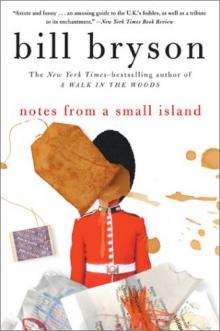 Notes from a Small Island
Notes from a Small Island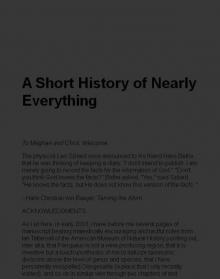 A Short History of Nearly Everything
A Short History of Nearly Everything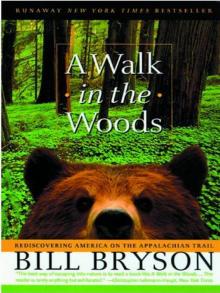 A Walk in the Woods
A Walk in the Woods I'm a Stranger Here Myself
I'm a Stranger Here Myself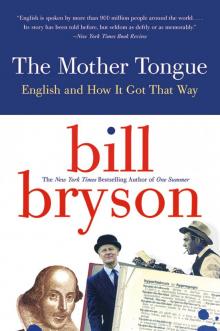 The Mother Tongue
The Mother Tongue Shakespeare
Shakespeare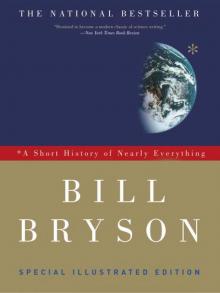 A Short History of Nearly Everything: Special Illustrated Edition
A Short History of Nearly Everything: Special Illustrated Edition The Best American Travel Writing 2016
The Best American Travel Writing 2016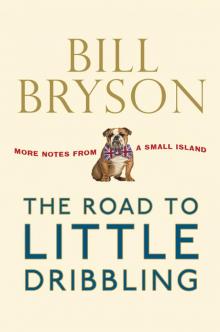 The Road to Little Dribbling
The Road to Little Dribbling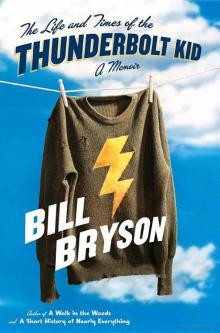 The Life And Times Of The Thunderbolt Kid: A Memoir (v5.0)
The Life And Times Of The Thunderbolt Kid: A Memoir (v5.0)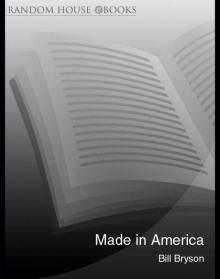 Made In America
Made In America Seeing Further
Seeing Further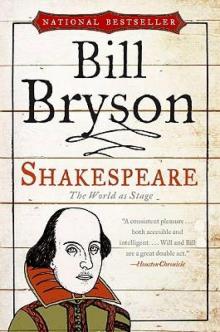 Shakespeare: The World as Stage
Shakespeare: The World as Stage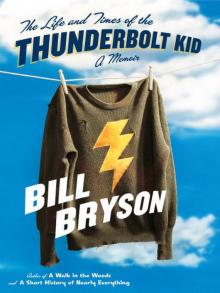 The Life and Times of the Thunderbolt Kid
The Life and Times of the Thunderbolt Kid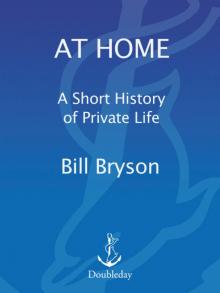 At Home
At Home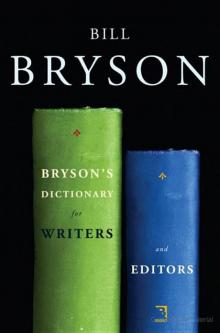 Bryson's Dictionary For Writers And Editors (v5.0)
Bryson's Dictionary For Writers And Editors (v5.0) Neither Here Nor There
Neither Here Nor There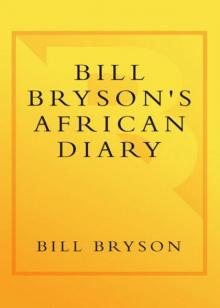 Bill Bryson's African Diary
Bill Bryson's African Diary